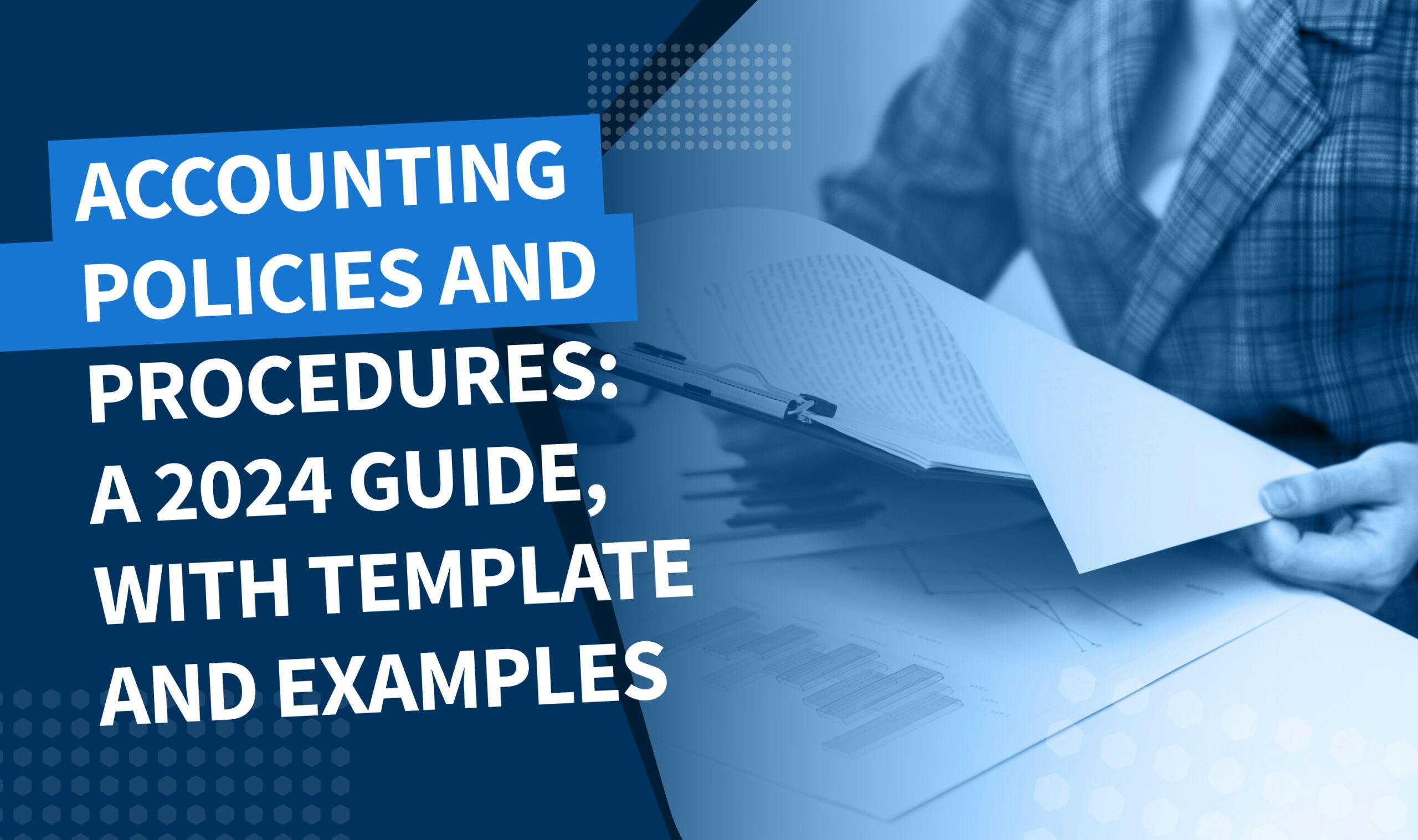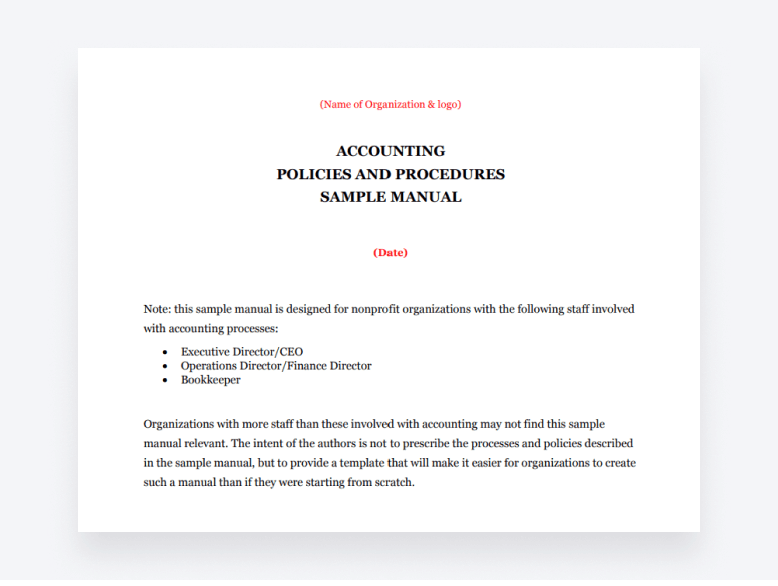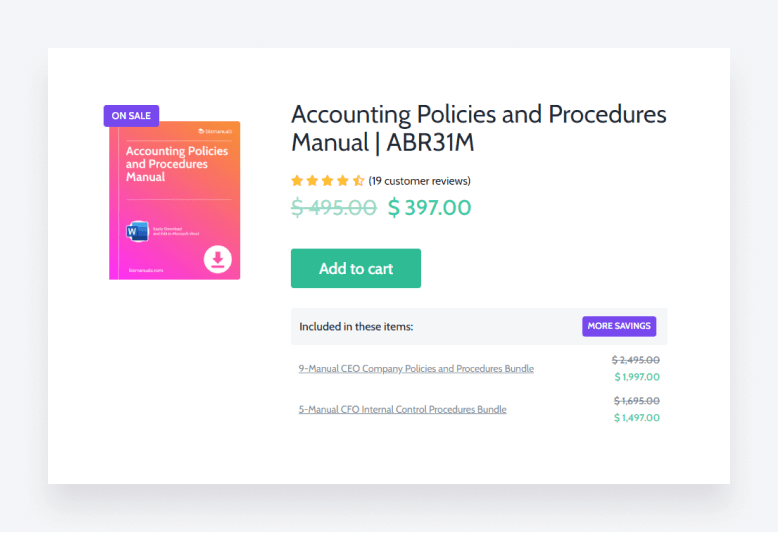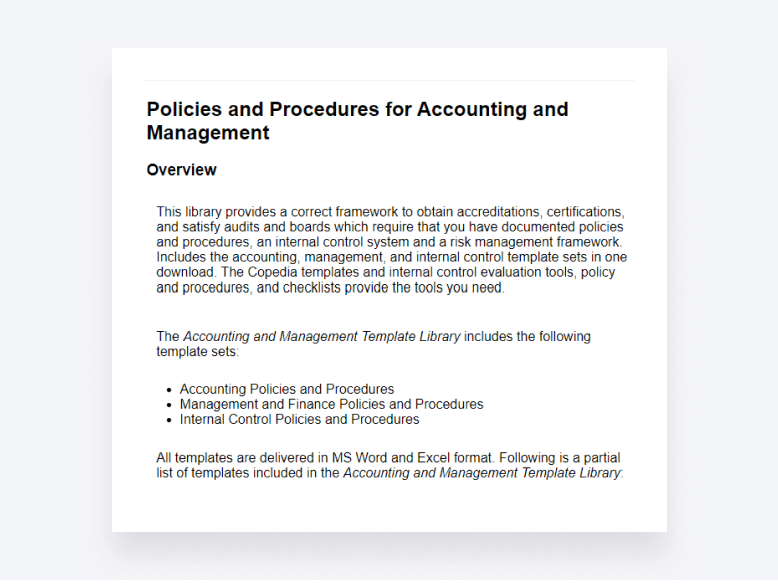
When it comes to running a successful business, consistency is key. The more complex the business environment becomes, the greater the need for standardized processes and procedures.
This is especially true in accounting, where consistency and accuracy aren’t just nice-to-haves, they’re essential. But given the complexity of modern accounting, how do you ensure that you have reliable processes in place? The answer is with an accounting policies and procedures manual.
In this guide, we’ll explain everything you need to know about creating and implementing effective accounting policies and procedures, including:
- The key advantages
- Important elements to include
- A free template you can take away and use
- Some real-life examples of accounting policies and procedures in action
Let’s get started.
What are accounting policies and procedures?
Accounting policies and procedures are the official framework that your organization follows for all accounting-related matters, from routine transactions to complex reporting.
By providing clear guidelines and standardizing processes, they enhance transparency, accuracy and consistency in financial record-keeping. This helps to prevent errors, discrepancies and even fraud.
To understand the difference between these two terms, let’s look at a couple of definitions:
- Accounting policies: the overarching principles and guidelines that define how you approach accounting
- Accounting procedures: the detailed steps and methods that outline how specific accounting processes are performed
Together, these form the foundations for successful accounting practices within an organization.
What are the advantages of implementing accounting policies and procedures?
There are plenty of advantages to implementing accounting policies and procedures. This isn’t just a bureaucratic box-ticking exercise, after all. It’s a strategic move that can yield tangible results for your organization.
Let’s explore some of the most important benefits.
1. Consistency and accuracy
With clear accounting policies and procedures, you can establish standardized practices for recording, classifying and reporting transactions. This means that accounting processes are handled consistently at scale — regardless of personnel changes — leading to fewer errors and discrepancies.
2. Improved regulatory compliance
Given today’s ever-evolving regulatory environment, accounting policies and procedures act as a shield against legal complications. These frameworks help ensure that your financial practices are compliant with the latest industry regulations and reporting requirements. This helps you avoid penalties, legal disputes and the reputational damage that comes with both.
3. Efficient decision-making
Standardizing your financial processes allows you to analyze and interpret financial data more efficiently, enabling better decision-making. This empowers leaders to respond more proactively to opportunities and challenges.
4. Transparency and accountability
Well-documented accounting policies and procedures provide clarity around how financial transactions are handled. This transparency makes your organization more accountable, as every financial process can be traced back to standardized procedures.
5. Fraud prevention
By defining controls, responsibilities and authorization processes, you can create a system that not only reduces the potential for accounting fraud but also makes it easier to detect.
6. Seamless onboarding and training
New employees can seamlessly integrate into your finance team when there are clear policies and procedures in place. This information can double as training materials, providing newcomers with a structured understanding of how financial tasks are executed.
7. Streamlined audits
Having an accounting policies and procedures manual simplifies the audit process. Auditors can easily verify that your financial practices align with industry standards and regulations. This saves time during the audit process, reduces stress and demonstrates your commitment to financial accuracy.
Key elements for your firm’s policies and procedures manual
So what exactly should you include in your policies and procedures manual? Let’s explore some key elements to consider. It’s worth noting, however, that manuals vary from firm to firm, and your business will have its own requirements.
1. Accounting principles and objectives
Outline the accounting principles your organization follows, such as the Generally Accepted Accounting Principles (GAAP) or the International Financial Reporting Standards (IFRS).
Depending on the size of your organization and where you operate, you might need to cover multiple accounting standards. If that’s the case, clearly explain when specific accounting standards are applicable, and why.
2. Organizational structure
Outline the structure of your finance department, including the roles and responsibilities of key personnel. This will help people from across the organization understand who is responsible for what within the accounting function.
3. Chart of accounts
A chart of accounts is like an index of all the accounts in your organization’s general ledger. Each account is indexed and categorized using an identification code, providing a complete view of all accounts and transactions in one place.
4. Transaction procedures
Make sure you outline standardized procedures for common financial transactions, such as sales, purchases, payroll and asset acquisitions. Remember to include:
- Step-by-step instructions
- Detailed approval processes
- Documentation requirements for each type of transaction
5. Revenue recognition
Specify the criteria for recognizing revenue, especially if your business deals with complex revenue streams. Address issues like when revenue is realized or realizable and earned.
6. Expense recognition
Define the principles for recognizing expenses, including when they are incurred and matched to corresponding revenues. Ensure that your expense recognition aligns with your revenue recognition policies.
7. Financial reporting
Explain the timing and frequency of financial reporting, as well as any specific formats or templates that should be used. Outline the processes involved in preparing financial statements, including:
- Balance sheets
- Income statements
- Cash flow statements
8. Closing periods
Different jurisdictions have different financial years, so it’s important to clarify the key dates that matter to your accounting department. It’s also important to define the month-end and year-end closing processes in a detailed, step-by-step manner.
9. Internal controls
Detail the internal controls that your organization has in place to safeguard financial assets, prevent fraud and ensure data accuracy. Focus on areas such as:
- Segregation of duties
- Authorization processes
- Reconciliation procedures
10. Compliance and regulations
Specify how your organization ensures compliance with relevant laws and regulations, industry standards and any specific reporting requirements.
11. Documentation
Maintaining comprehensive documentation for all financial transactions and processes is key. Describe how these processes look in your organization, focusing on:
- Record-keeping practices
- Retention periods
- The accessibility of financial records
11. Reporting and communication
Clarify how — and at what intervals — financial information is communicated within the organization. Include a process for reporting financial results to different stakeholders, including:
- The wider organization
- Management
- The board of directors
- External stakeholders
12. Updates and revisions
Given the ever-changing nature of accounting, your policies and procedures will need reviewing and updating periodically. Outline when and why you would need to review and update your manual, and who is responsible for decisions around this process.
13. Training and onboarding
Your accounting policies and procedures manual represents valuable training material for new hires in the accounting and finance department. Outline how they will be used in training and onboarding, at what stage and who is responsible for overseeing the process.
Free accounting policies and procedures template
Creating your own policies and procedures can be a complicated and time-consuming job. So, to make things easier, we’ve prepared a free template that you can use.
Access your free accounting policies and procedures template.
Please note: This template should be customized to suit the needs of your business, with each section requiring careful consideration and detailed input. You may find that some sections are irrelevant to your organization and can be deleted, while other sections may be missing and need adding in.

Real examples of accounting policies and procedures
Now you’ve got your hands on a template, let’s look at some real-life examples of accounting policies and procedures manuals.
1. Sample manual for nonprofit organizations

This sample manual offers a guide for how nonprofit organizations can set out their accounting policies and procedures.
It’s a very detailed document with little room for flexibility. For example, it’s designed for nonprofit organizations with a three-tier accounting hierarchy, comprising a c-level executive, a director and a bookkeeper.
But even if that isn’t your exact setup, this manual still has plenty to offer. In particular, it’s useful as a guide for tackling the unique challenges that come with nonprofit accounting.
2. Bizmanualz

Bizmanualz has specialized in crafting templates for business policies, procedures and processes since 1995. They offer a range of downloadable Word documents that businesses can edit and customize to suit their needs.
Their accounting manual is a great template for businesses looking to streamline the writing process. Written by experienced CPAs, it could save your business countless hours and includes detailed policies and procedures for:
- Revenue
- Cash
- Purchasing
- General and administrative expenses
- Inventory
- Assets
Unlike some of the options out there, however, this manual comes at a relatively high one-off cost.
3. Copedia

Copedia is another provider of business templates. Besides accounting, they offer ready-made templates for HR, sales, safety, compliance and more.
Their template is designed to help your business create a manual that covers all the relevant and important aspects of corporate accounting. They also have a separate template for nonprofits.
Besides templates, you also get relevant content, spreadsheets and checklists to help you create a comprehensive manual.
Conclusion
Accounting policies and procedures play a central role in safeguarding your organization’s financial health and ensuring regulatory compliance. By standardizing processes, they ensure accuracy, reliability and thoroughness in your accounting practices. They also make your business more accountable and transparent.
By using the information and template provided in this article, you have everything you need to craft a comprehensive, well-written policies and procedures manual.
And remember: your manual will be more than just an administrative document. It’ll be the backbone of your accounting function, ensuring the financial health of your business for years to come.

Thank you! The eBook has been sent to your email. Enjoy your copy.
There was an error processing your request. Please try again later.
Looking to boost your firm's profitability and efficiency?
Download our eBook to get the answers



